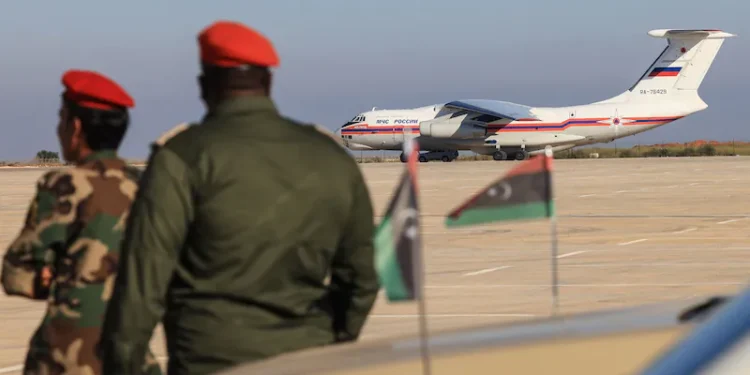The fall of Russian ally Bashar al-Assad in Syria has compelled the Kremlin to reassess its strategic objectives in the Mediterranean and Africa. With its foothold in Syria compromised, Russia is turning its attention to Libya as a potential new base of operations, experts suggest.
At Khmeimim air base in Syria, two Antonov AN-124 cargo planes were seen with their nose cones open, preparing to load as dozens of vehicles lined up on the tarmac. This air base has long served as Russia’s bridge to Africa through Syria. The daily air traffic from Syria to Libya has increased significantly, as Russian officials and displaced Syrian allies seek refuge and alternative locations for their naval assets. Satellite images reveal Russian mercenaries building and expanding logistical bases in southern Libya, near the borders of Chad and Sudan.
Previously, Russia operated a military port and an airbase on the Syrian coast, supporting its operations in the Mediterranean, the Middle East, and sub-Saharan Africa—particularly in the Sahel, Sudan, and the Central African Republic. However, the change in Syria’s leadership has disrupted Moscow’s plans. Although Syria’s new leader, Ahmed al-Sharaa, acknowledged Russia as an “important country” and expressed a desire for continued relations, the shifting political landscape has pushed Russia to seek alternative strategies.
In Libya, Russia has established connections through Field Marshal Khalifa Haftar and his Libyan National Army (LNA). Russia has supplied the LNA with Wagner Group mercenaries, attack aircraft, and weaponry. Until a ceasefire in 2020, the LNA engaged in a six-year civil war against the Tripoli-based Government of National Accord (GNA), which was backed by Turkey.
In May 2024, the investigative consortium “All Eyes On Wagner” identified Russian activities at approximately ten sites in Libya, including the port of Tobruk, where military equipment was delivered in February and April of the previous year. Reports indicate that around 800 Russian troops were present in Libya in February 2024, with numbers increasing to 1,800 by May.

On December 18, citing Libyan and American officials, the Wall Street Journal reported that Russia had transferred radars and defense systems from Syria to Libya, including S-300 and S-400 anti-aircraft batteries. Following Assad’s fall on December 8, there has been a significant increase in Russian military resources being shipped to Libya from Belarus and Russia, including troop deployments.
This January, Libyan Commander Khalifa Haftar granted Russian forces control of the Maaten al-Sarra air base near the Chad-Sudan border.
The base, previously used in the 1980s Libyan-Chadian war, is being rebuilt by Russian forces with support from Syrian soldiers fleeing the Assad regime.
Infrastructure upgrades include restoring runways and warehouses to supply regions like Mali, Burkina Faso, and Sudan, signaling Russia’s growing influence in Africa following setbacks in Syria.
Russia now operates four major air bases in Libya: Al-Khadim (east), Al-Jufra (central), Brak al-Shati (southwest), and Al-Qardabiya (Sirte region).
Al-Khadim also known as Al-Kharouba airport, is inside territory controlled by the Libyan National Army (LNA). Russia and the UAE already operates aviation assets o the base since 2016. The Al-Khadim base will reportedly host Russia’s “African Corps,” an alternative to Wagner, with former Syrian officers among its ranks.
Ukrainian intelligence claimed on January 3 that Russia planned to use the cargo ships Sparta and Sparta II to transport military equipment and weapons to Libya. Experts suggest that Russia’s shift represents a quest for continuity in its regional strategy. Libya offers an opportunity to disrupt Western interests and extend Moscow’s influence into Africa.
According to analyst Emadeddin Badi of the Atlantic Council, Libya could serve a similar strategic purpose for Russia as Syria did under Assad. Haftar provides Moscow with a means to challenge Western influence, exploit Libya’s political fractures, and expand its reach into Africa.
However, Russia faces challenges in replicating its Syrian operations in Libya. The political environment in Libya is more complex, with multiple factions and foreign powers involved. The Tripoli government and Italy have expressed concerns over Russian movements, which are being closely monitored by the European Union and NATO. The United States has reportedly attempted to persuade Haftar to deny Russia a permanent installation at the port of Tobruk.
Additionally, Libya lacks deep-water port facilities like those in Tartus, Syria, complicating Russia’s naval logistics. Tobruk would require substantial development to accommodate Russia’s larger naval assets. The Kremlin must also navigate relationships with other influential players in Libya, including Turkey, which supports the GNU, and Egypt and the United Arab Emirates, which back Haftar.
Russia must consider contingency plans should their alliance with Haftar falter. Haftar himself may be hesitant to fully align with Russia at the expense of relationships with Western nations that have offered tacit support.










